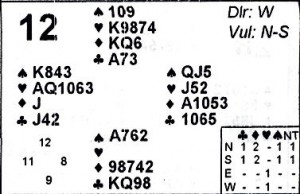I was done in by Mel Colchamiro’s Rule of Nine Continue reading
Mel Colchamiro proposed a formula for determining whether to pass when one’s partner makes a takeout double of an opponent’s low-level bid. One simply adds together the number of trump one holds and the number of honors (ten through ace) in the trump suit. To that one adds the level at which the opponents have bid. If the total is nine or higher, one should, according to Colchamiro, pass. If the total is less than nine, one should make a bid.
I have achieved good results by using this rule. Last night, however, I applied it on the following hand with disastrous results. 
I was sitting North. West opened 1♥, and East raised to 2. My partner prebalanced with a takeout double, and West passed. I applied the rule of nine:
- Five trump;
- plus one honor in trump;
- plus the opponents had bid at the two level.
The total was only eight, and so I bid 2NT, which was doomed. I should have passed. We can easily defeat 2♥, and we cannot make any contract that is higher. The rule of nine was just wrong in this case.
They say that you cannot play results, but I have decided that the rule of nine needs a slight adjustment. My heart holding is surely more valuable than a Q-J-10 tripleton, for which Mel’s formula would have produced the same total. My hand virtually guaranteed two trump tricks, and if West ever ruffed anything, I would have control of trump. If I had had the Q-J-10 tripleton, I would have had one certain trump trick, but I would have had little chance of a second and no likelihood of ever gaining trump control.
So, from now on, instead of counting honors in trump, I plan to count likely trump tricks. By this reckoning, I would have bid with a Q-J-10 tripleton but passed with my actual holding of K-9-8-7-4.

